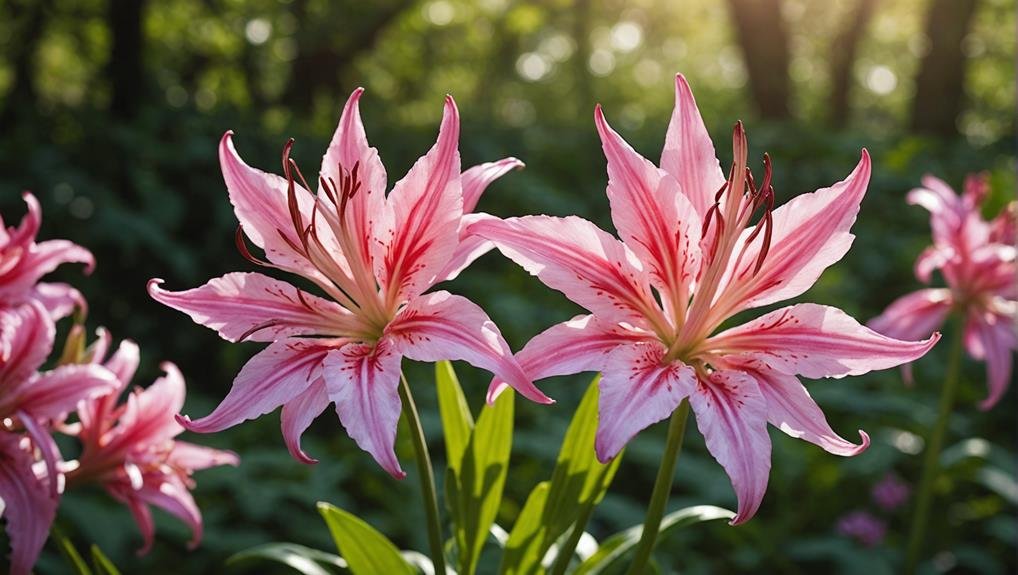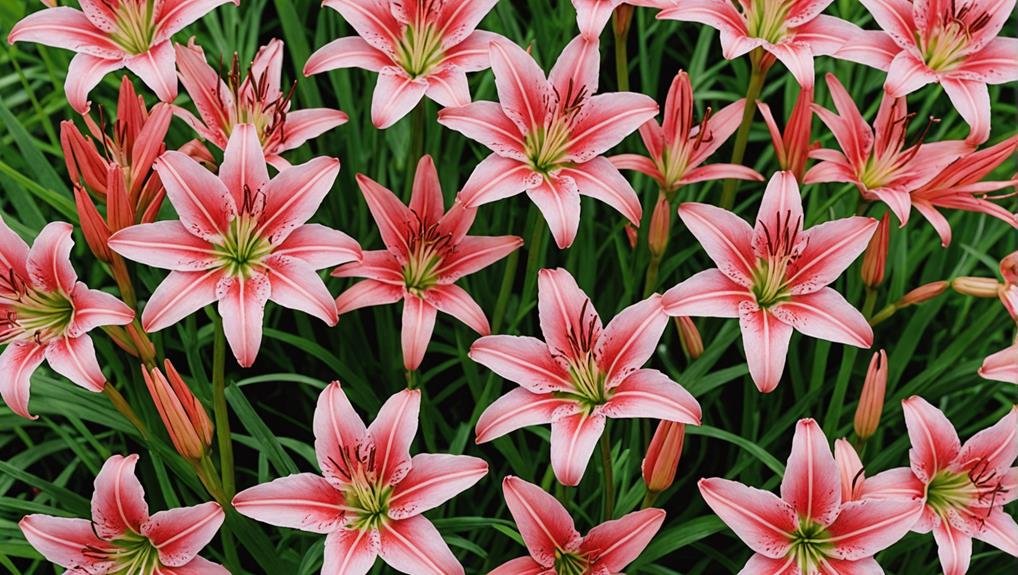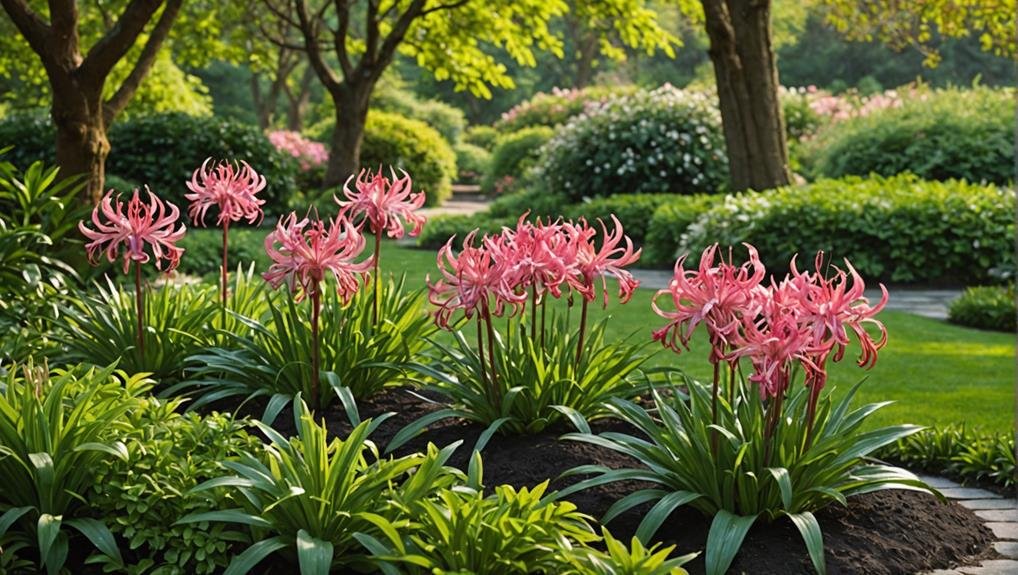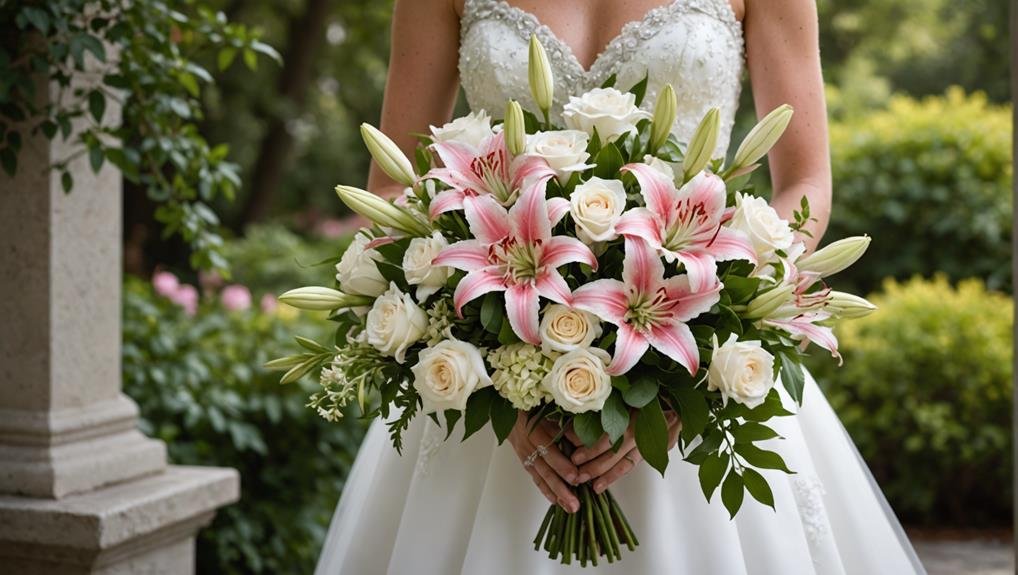When planning a wedding, the choice of flowers plays a pivotal role in setting the tone and ambiance of the event. Nerine, often referred to as the Guernsey Lily or Jersey Lily, stands out as an elegant choice with its slender stems and delicate, funnel-shaped blooms available in a vibrant array of colors. These flowers not only enhance bouquets and centerpieces but also offer a remarkable vase life of 10-14 days, ensuring their beauty endures throughout your celebration. Discover how the year-round availability and versatile applications of nerine can transform your wedding decor into an unforgettable visual experience.
Flower Overview

Nerine, commonly known as Guernsey Lily or Jersey Lily, is a strikingly vibrant species of flowering plant native to South Africa. These flowers are celebrated for their diverse color palette, which includes shades of white, red-orange, pink, and crimson, making them a versatile choice for various floral arrangements. Often used in late summer and autumn weddings, nerines add bright splashes of color that can complement a wide range of themes and styles.
The popularity of nerines in wedding arrangements can be attributed to their impressive vase life of 10-14 days and their ideal stem length of 40-50 cm, both of which ensure that they maintain their beauty and freshness throughout the event.
When selecting nerine flowers, it is advisable to choose partially open blooms with colored but not fully open buds. This selection strategy guarantees maximum longevity and visual appeal in bouquets.
In floral compositions, nerines can be paired with other elegant flowers such as parrot tulips to create stunning displays that captivate the eye. Their ability to blend seamlessly with other flowers, particularly those in shades of white, makes them an invaluable addition to sophisticated wedding floral arrangements.
Physical Description
Characterized by their long, slender stems and delicate, funnel-shaped blooms, these flowers exhibit a vibrant array of colors including reds, oranges, pinks, whites, and ivories. Originating from South Africa, Nerine flowers are renowned for their elegance and versatility, making them a popular choice for wedding flowers. Their graceful appearance is further complemented by their sturdy stems, which can support the intricate blooms in various floral arrangements.
Nerines possess a vase life of 10-14 days, ensuring that wedding bouquets and centerpieces maintain their beauty throughout the event. The blossoms themselves are often described as both delicate and striking, with a unique curvature that adds depth and dimension to any arrangement. Their availability year-round allows florists to incorporate them into designs regardless of the season, providing consistency and reliability for wedding planning.
Below is a table summarizing the key physical characteristics of Nerine flowers:
| Feature | Description | Ideal For |
|---|---|---|
| Stem Length | Long and slender | Floral arrangements |
| Bloom Shape | Delicate, funnel-shaped | Bouquets and centerpieces |
| Color Range | Reds, oranges, pinks, whites, ivories | Versatile design options |
| Vase Life | 10-14 days | Long-lasting displays |
The unique attributes of Nerine flowers make them a favored choice for wedding flowers, providing both visual appeal and longevity.
Available Colour Varieties

With a spectrum of vibrant hues, these flowers offer versatile color options for any wedding theme. Nerine flowers are available in a stunning array of colors, including white, red-orange, pink, and crimson. This diverse palette allows for a wide range of floral arrangements, catering to different color symbolism preferences.
For instance, white Nerines can signify purity and elegance, while red-orange or crimson shades may evoke passion and energy.
Incorporating Nerines into bouquet options is seamless due to their vivid colors, which can be easily mixed with other flowers to create visually striking combinations. Whether paired with soft pastels for a romantic look or bold hues for a modern twist, Nerines enhance the overall aesthetic of the bouquet.
Given their popularity in Australia during late summer and autumn, Nerines align well with seasonal color trends, making them a timely choice for weddings during these periods. Additionally, commercially cultivated Nerines are available when they are out of season, ensuring their availability year-round.
For DIY decorations, selecting partially open Nerine flowers with colored but not fully open buds ensures prime freshness and longevity, making them a practical and beautiful choice for personalized wedding décor.
Latin Name and Taxonomy
Belonging to the family Amaryllidaceae, the Latin name for this vibrant flower is Nerine spp. This genus encompasses several species commonly referred to as Guernsey Lily or Jersey Lily. The taxonomic classification of Nerine places it within the monocot order Asparagales, renowned for its ornamental appeal and use in wedding bouquets and floral displays.
Nerine holds rich symbolic meanings, often associated with beauty and elegance. Its mythological origins trace back to the Nereids, sea nymphs in Greek mythology, signifying its enchanting allure and timeless grace. These historical and cultural connections enhance the flower’s desirability for special occasions, especially weddings.
In terms of growing requirements, Nerine thrives in well-drained soil and prefers a sunny location. It is relatively adaptable but flourishes best in temperate climates. Propagation methods typically involve division of bulbs or from seed, although the former is more common due to its reliability and faster establishment.
Whether chosen for their striking colors—ranging from white and pink to red-orange and crimson—or their storied past, Nerine flowers offer both aesthetic and sentimental value, making them a favored choice for meaningful celebrations.
Geographical Origins

Originating from the diverse landscapes of South Africa, Nerine flowers are celebrated for their vibrant hues and ornamental charm. Known commonly as Guernsey Lily or Jersey Lily, these striking blooms have captured the attention of horticulturists and florists worldwide, leading to their extensive global dissemination.
Nerines thrive in specific climate preferences, flourishing best in regions that mimic their native South African environment. These areas typically feature mild, wet winters and hot, dry summers, conditions that facilitate the prime growth and vibrant blooming of these flowers. Despite their specific climate needs, Nerine flowers have successfully adapted to various parts of the world, including Australia, where they bloom from late summer to autumn.
The ecological impact of Nerine flowers is also remarkable. Their ability to adapt to different environments without becoming invasive makes them an environmentally friendly choice for gardens and floral arrangements. Additionally, their resilience and low maintenance requirements make them a sustainable option for commercial cultivation.
To summarize, the geographical origins of Nerine flowers highlight:
- Global dissemination: From South Africa to Australia and beyond.
- Climate preferences: Mild winters and hot, dry summers.
- Ecological impact: Adaptability and non-invasive nature.
Season Availability
Nerine flowers are mainly available from late summer to autumn, making them an ideal choice for weddings and events during these seasons. Their availability during these months aligns perfectly with various wedding themes and ensures that floral arrangements and event decorations are both timely and seasonally appropriate. In Australia, these exquisite flowers are commercially cultivated and can be sourced locally during their peak season, providing freshness and vibrant beauty for your special occasion.
When planning a wedding or event, it is essential to take into account the seasonality of flowers. Nerines, with their striking appearance, can enhance any floral arrangement and lend an air of sophistication to event decorations. For those planning events outside of nerine’s natural season, importing these flowers is a viable option to make sure their presence year-round.
| Availability | Details |
|---|---|
| Local Sourcing | Late summer to autumn |
| Imported | All year round |
| Vase Life | 10-14 days with proper care |
To maximize the vase life of nerine flowers, choose stems with partially open blooms and store them in cool rooms at temperatures between 2-4°C. Utilizing flower food will also help maintain their freshness and extend their visual appeal.
Growing Conditions

Understanding the ideal growing conditions for nerines is essential to ensuring their vibrant presence in floral arrangements and wedding decor. To achieve best growth, it is important to take into account several key factors:
Soil Composition and Sunlight Exposure:
Nerines thrive in well-draining soil, preventing water from pooling around the roots. Full sun exposure is crucial, as it promotes robust flowering and healthy plant development.
Watering Frequency and Root Rot Prevention:
Moderate watering is necessary. Allow the soil to dry out between waterings to prevent root rot, a common issue that can severely impact the plant’s health.
Frost Protection and Bulb Division:
In colder climates, protecting nerine bulbs from frost is vital. Using mulch or relocating pots indoors can help. Dividing bulbs every few years is also advantageous, as it rejuvenates the plant and promotes vigorous growth.
Cultural Significance
The cultural significance of nerine flowers is deeply rooted in their historical connections and symbolic meanings. Named after the sea nymphs of Greek mythology known as Nereids, these flowers carry a sense of mystique and allure that has fascinated various cultures over centuries.
Originating from South Africa, nerine flowers have traversed continents, enriching floral traditions with their vibrant hues and distinctive shapes.
The historical significance of nerine flowers extends beyond their mythological roots. In Victorian England, they symbolized freedom and resilience, often used in floral arrangements to convey these messages. Their striking colors, ranging from white to crimson, have made them a symbol of beauty and elegance in numerous cultural contexts.
Traditional uses of nerine flowers are varied and meaningful. In South African culture, these blooms are often associated with renewal and transformation, given their seasonal bloom in late summer to autumn. They have also found a place in religious and celebratory settings, where their long vase life and vivid appearance make them a popular choice for enhancing the aesthetic of various events.
Typical Use in Weddings

With their exquisite appearance and vibrant colors, nerine flowers are frequently chosen to enhance wedding bouquets and floral arrangements. Their delicate beauty and long stems make them ideal for creating visually appealing displays, ensuring they stand out in various wedding settings.
Available year-round, nerines offer consistent availability, allowing florists to incorporate them seamlessly into different floral designs.
Nerine flowers are versatile and can be used in a variety of wedding elements:
Bridal bouquets and Reception centerpieces:
Their vibrant colors, ranging from reds and oranges to whites and pinks, add a unique touch to bridal bouquets and reception centerpieces, creating a cohesive and stunning look.
Ceremony decor and Floral arrangements:
The long stems of nerines make them perfect for tall ceremony decor and intricate floral arrangements, providing an elegant and sophisticated ambiance.
Table settings and Bridal party florals:
With a vase life of 10-14 days, nerines maintain their beauty, making them an excellent choice for table settings and bridal party florals, ensuring fresh and alluring displays throughout the celebration.
Alternative Flower Types
Exploring different flower varieties for wedding arrangements can diversify and enhance the visual appeal of any floral design. In the domain of floral trends, several options stand out as compelling substitutes for nerine. Garden roses, for example, exude a Victorian charm that can evoke a timeless elegance. Scabiosa, with its intricate blooms, adds a delicate touch to any arrangement, making it ideal for those seeking bouquet inspiration with a lighter, more ethereal feel.
Anemones are another excellent choice, offering a modern look with their striking contrasting centers, perfect for contemporary weddings. Parrot tulips, with their bold and colorful petals, bring an element of drama and vibrancy, which can be particularly eye-catching in DIY arrangements. Finally, protea stands out with its large, striking blooms, providing a standout focal point for wedding bouquets and centerpieces.
| Flower Type | Unique Feature |
|---|---|
| Garden Roses | Victorian charm |
| Scabiosa | Delicate, intricate blooms |
| Anemone | Modern look with contrasting centers |
| Parrot Tulips | Bold, colorful petals |
| Protea | Large, striking blooms |
Incorporating these different flower types not only aligns with current floral trends but also offers endless possibilities for creating unique and memorable wedding florals.
